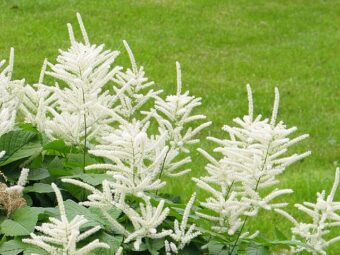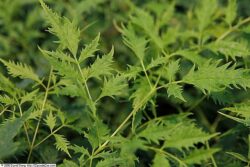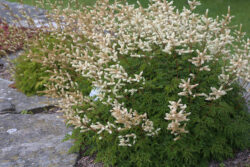In this article, we will be discussing how to grow the clump-forming herbaceous perennial of Aruncus in containers. It is hard to believe but it is actually a member of the rose family. It is a small group of species, where the botanists cannot agree if one or four species exist.

The recognised species is Aruncus dioicus (Goat’s Beard), whilst Aruncus aethusifolius, Aruncus gombalanus and Aruncus sylvestris are not recognised by all botanists. They are native to woodland areas in the Northern hemisphere in cold areas.
They are noted for looking like a giant Astilbe but instead, they produce feathery plumes of tiny creamy-white flowers that tower over the veined and toothed pale green leaves. The flowers are more spectacular in males, but the female produces interesting seed heads.
Find out how to grow this perennial in containers in this article.
GROWING ARUNCUS IN CONTAINERS
Usually, you will buy Aruncus as garden-ready plants but they can be grown from seed, which is trickier than buying plants.
GROWING ARUNCUS FROM SEED
You will need to sow seeds indoors in spring and summer but this is harder than growing them in autumn/winter. This is because the seeds need a period of cold to ‘break’ dormancy.
First, you will need to sow under glass in early autumn (greenhouse or cold frame) by filling a seed tray with seed sowing compost and watering it well until the growing media is moist. Sow the seeds onto the surface of the compost thinly and just cover with a sprinkling of sieved seed compost. Allow the natural winter cold (leave the seeds outside) to break the seeds’ natural dormancy and to start the germinating process.

Be warned the germination can be erratic and it will take time to get going (even next spring). Once it has germinated and the seedlings are big enough to handle, then you can prick them out and transplant them individually into 7.5cm pots full of multipurpose compost.
ALLOW THE SEEDLINGS TO GROW ON
Allow them to grow on throughout the growing season and in autumn they should be big enough to be able to be planted out in containers.
At this point, garden-ready plants and home-reared plants can be treated in the same way. First, you must release that they are large plants and need plenty of room. This means you will need to use a large container as possible, a half-barrel will be ideal.
I may shock my regular readers but do buy any container with drainage holes or create any drainage holes. You see they prefer to grow in water-retaining compost or boggy compost.
On top of this add a moisture-retentive multipurpose compost to 5cm near the top rim. To the centre of the pot, dig a hole slightly larger than the root ball it came in the original container. Drop the plant in so that top of the root ball is at the same level as the top surface of the compost. Backfill with the growing media making sure that no gaps remain, using more compost if it’s necessary. Firm the plant in and water well.
GROWING CONDITIONS

Do not place the container in full sun as this can affect the plant. They prefer to grow in partial shade.
It is a slow-growing perennial as it will take a long time to grow to its final size.
You will need to water regularly throughout the growing season as the compost must never be allowed to dry out. In hot weather, you will need to water daily or more than once a day.
You may find it beneficial to feed every spring with some slow-release fertilizer to give it a boost throughout the year. Once the flowers have died back, you can cut the stems down to tidy the plant up to 2 to 3 cm above the ground level.
You will need to divide the plant clumps every few years to give new vigour to the newly divided plants. Each division can be planted into new compost in new pots, as long as each division has one growing point from them. If it gets too mature, it can become too tough and difficult to split.
PESTS AND DISEASES
In general, the plants will not suffer from much in the way of pests and diseases. Sawflies and caterpillars can be a problem in spring. Best to deal with by hand removing or spraying with a suitable systemic insecticide.
VARIETIES TO GROW
The main variety is Aruncus dioicus (sometimes listed as A. sylvestris) which has fern-like leaves and large plumes of white flowers that grow up to 1.8m tall. More compact varieties include ‘Glasnevin’ that grows up to 1.2m high or ‘Kneiffii’ that grows up to 0.9m high.
An even more compact variety is Aruncus aethusifolius which only grows up to 1m high and still produces tall white flower spikes.
CONCLUSIONS
In this article, we have discussed the regal plant of Aruncus in containers. They are not only big, bold and beautiful but they are easy to grow, easy to look after and relatively pests and disease-free. As long as you keep the compost moist at all times, they will do well.
If you have any questions or comments that you wish to make on growing Aruncus in containers, please do so in the comment box below.
Happy Arunchus growing.
